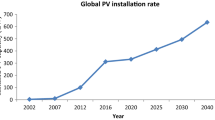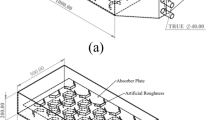Abstract
Buildings represent a large part in terms of fossil energy consumption, which depends on the great need for heating. Even if the solar absorption heat storage system is possible, the performance of this system is affected by the cycle limits and the climatic conditions. The goal of the present study is to control the thermal performance of the system cycle according to the imposed climatic conditions of Bucharest city, Romania, and therefore a numerical model was developed for this purpose. The scheme and the thermodynamic cycle, the energy and mass balance equations, and the computational algorithm were presented. The results show that the cycle temperature increases at the end of desorption when the heating power supplied to the desorber is increased, which is also proportional to the drop in temperature at the beginning of the desorption. The temperature at the end of absorption and the mass flow rates of the solution have a significant effect on the thermal power released from the absorber and used to heat the building. For an average daily heat power of 1.35 kW/m2 and 10 hours per day of heating the building, the system with a solar collector area of 3 m2 has the capacity of heat supply for all the cold period. However, an economic strategy remains necessary.
Similar content being viewed by others
Abbreviations
- A :
-
area (m2)
- a 1 :
-
first-order loss coefficient (W/(m2·K))
- a 2 :
-
second-order loss coefficient (W/(m2·K2))
- h :
-
specific enthalpy (J/kg)
- I :
-
solar radiation (W/m2)
- ṁ :
-
mass flow rate (kg/s)
- p :
-
pressure (kPa)
- \(\dot q\) :
-
heat flux density (W/m2)
- Q :
-
heat amount (W·h)
- \(\dot Q\) :
-
thermal power (W)
- r :
-
sensible heat percentage (%)
- T :
-
temperature (°C)
- t :
-
time (h)
- U :
-
overall heat transfer coefficient (W/(K·m2))
- x :
-
mass fraction (%)
- ΔT :
-
temperature step
- ε :
-
convergence error
- η :
-
efficiency (%)
- η 0 :
-
optical efficiency (%)
- a:
-
absorption
- amb:
-
ambient
- avg:
-
average
- ba:
-
beginning of absorption
- bd:
-
beginning of desorption
- c:
-
condensation
- com:
-
comfort
- cry:
-
crystallization
- d:
-
desorption
- e:
-
evaporation
- fa:
-
ending of absorption
- fd:
-
ending of desorption
- gn:
-
generator
- h:
-
heating
- hf:
-
heating floor
- i:
-
inlet
- max:
-
maximum
- min:
-
minimum
- o:
-
outlet
- ref:
-
reference
- sc:
-
solar collector
- sh:
-
superheated
- sr:
-
sunrise
- so:
-
solution
- ss:
-
sunset
- tot:
-
total
- th:
-
thermal
- v:
-
water vapor
References
Ahmad MW, Mourshed M, Yuce B, Rezgui Y (2016). Computational intelligence techniques for HVAC systems: A review. Building Simulation, 9: 359–398.
Alva G, Liu L, Huang X, Fang G (2017). Thermal energy storage materials and systems for solar energy applications. Renewable and Sustainable Energy Reviews, 68: 693–706.
ASHRAE (1997). ASHRAE Handbook: Fundamentals. Atlanta, GA, USA: American Society of Heating, Refrigeration and Air-Conditioning Engineers.
Aydin D, Casey SP, Chen X, Riffat S (2016). Novel “open-sorption pipe” reactor for solar thermal energy storage. Energy Conversion and Management, 121: 321–334.
Bi Y, Zang G, Qin L, Li H, Wang H (2019). Study on the characteristics of charging/discharging processes in three-phase energy storage coupling in solar air conditioning system. Energy and Buildings, 204: 109456.
BSI (2006). Thermal solar systems and components. Solar collectors. Part 2: Test methods. BS EN 12975-2: 2006. British Standards.
Castaing-Lasvignottes J (2001). Aspects thermodynamiques et technicoéconomiques des systèmes à absorption liquide. Institut français du froid industriel. Available at http://jc.castaing.free.fr/ens/abs/abscours.pdf.
Chekirou W, Chikouche A, Boukheit N, Karaali A, Phalippou S (2014). Dynamic modelling and simulation of the tubular adsorber of a solid adsorption machine powered by solar energy. International Journal of Refrigeration, 39: 137–151.
Chiu Y-H, Huang N-W, Wang C-C (2018). A comparison study of Taiwanese He-Yuan Architecture between the ethically spatial order and the condition of physical environment. Building Simulation, 11: 203–217.
Fallahi A, Guldentops G, Tao M, Granados-Focil S, Van Dessel S (2017). Review on solid-solid phase change materials for thermal energy storage: Molecular structure and thermal properties. Applied Thermal Engineering, 127: 1427–1441.
Florides GA, Kalogirou SA, Tassou SA, Wrobel LC (2003). Design and construction of a LiBr–water absorption machine. Energy Conversion and Management, 44: 2483–2508.
Frazzica A, Brancato V, Palomba V, Vasta S (2019). Sorption thermal energy storage. In: Frazzica A, Cabeza L (eds), Recent Advancements in Materials and Systems for Thermal Energy Storage. Springer International Publishing. Cham, Switzerland: Springer International Publishing.
Fumey B, Weber R, Baldini L (2017). Liquid sorption heat storage—A proof of concept based on lab measurements with a novel spiral fined heat and mass exchanger design. Applied Energy, 200: 215–225.
Garousi Farshi L, Seyed Mahmoudi SM, Rosen MA (2011). Analysis of crystallization risk in double effect absorption refrigeration systems. Applied Thermal Engineering, 31: 1712–1717.
Harkouss F, Fardoun F, Biwole PH (2018). Optimization approaches and climates investigations in NZEB—A review. Building Simulation, 11: 923–952.
Herold KE, Radermacher R, Klein SA (2016). Absorption Chillers and Heat Pumps, 2nd edn. Boca Raton, FL, USA: CRC Press.
Hong T, Langevin J, Sun K (2018). Building simulation: Ten challenges. Building Simulation, 11: 871–898.
Ibrahim NI, Al-Sulaiman FA, Ani FN (2018). Solar absorption systems with integrated absorption energy storage—A review. Renewable and Sustainable Energy Reviews, 82: 1602–1610.
Kurem E, Horuz I (2001). A comparison between ammonia-water and water-lithium bromide solutions in absorption heat transformers. International Communications in Heat and Mass Transfer, 28: 427–438.
Le Pierrès N, Huaylla F, Stutz B, Perraud J (2017). Long-term solar heat storage process by absorption with the KCOOH/H2O couple: Experimental investigation. Energy, 141: 1313–1323.
Lefebvre E, Fan L, Gagnière E, Bennici S, Auroux A, Mangin D (2015). Lithium bromide crystallization in water applied to an inter-seasonal heat storage process. Chemical Engineering Science, 133: 2–8.
Liu H, Le Pierrès N, Luo L (2009). Stockage inter-saisonnier d’énergie solaire pour l’habitat–performance du procédé en fonction du couple d’absorption. In: Proceedings of SFT 2009, Vannes, France. (in French)
Liu H, Edem NK, Nolwenn LP, Luo L (2011). Evaluation of a seasonal storage system of solar energy for house heating using different absorption couples. Energy Conversion and Management, 52: 2427–2436.
Liu Z, Song F, Jiang Z, Chen X, Guan X (2014). Optimization based integrated control of building HVAC system. Building Simulation, 7: 375–387.
Lizana J, Chacartegui R, Barrios-Padura A, Ortiz C (2018). Advanced low-carbon energy measures based on thermal energy storage in buildings: A review. Renewable and Sustainable Energy Reviews, 82: 3705–3749.
Mehari A, Xu ZY, Wang RZ (2020). Thermal energy storage using absorption cycle and system: A comprehensive review. Energy Conversion and Management, 206: 112482.
N’Tsoukpoe KE (2012). Etude du stockage à long terme de l’énergie solaire thermique par procédé d’absorption LiBr-H2O pour le chauffage de l’habitat. PhD Thesis, Université de Grenoble, France. (in French)
N’Tsoukpoe KE, Le Pierrès N, Luo L (2012a). Experimentation of a LiBr−H2O absorption process for long term solar thermal storage. Energy Procedia, 30: 331–341.
N’Tsoukpoe KE, Le Pierrès N, Luo L (2012b). Numerical dynamic simulation and analysis of a lithium bromide/water long-term solar heat storage system. Energy, 37: 346–358.
N’Tsoukpoe KE, Le Pierrès N, Luo L (2013). Experimentation of a LiBr-H2O absorption process for long-term solar thermal storage: Prototype design and first results. Energy, 53: 179–198.
N’Tsoukpoe KE, Perier-Muzet M, Le Pierrès N, Luo L, Mangin D (2014). Thermodynamic study of a LiBr–H2O absorption process for solar heat storage with crystallisation of the solution. Solar Energy, 104: 2–15.
Papadopoulos S, Kontokosta CE (2019). Grading buildings on energy performance using city benchmarking data. Applied Energy, 233–234: 244–253.
Prasartkaew B (2014). Performance test of a small size LiBrH2O absorption chiller. Energy Procedia, 56: 487–497.
Shirazi A, Taylor RA, Morrison GL, White SD (2018). Solar-powered absorption chillers: A comprehensive and critical review. Energy Conversion and Management, 171: 59–81.
Weather-Spark (2019). Average Weather in Bucharest Romania 2019. Available at https://weatherspark.com/y/93241/Average-Weather-in-Bucharest-Romania-Year-Round. Accessed 01 Jul 2019.
Xu ZY, Wang RZ (2019). Absorption seasonal thermal storage cycle with high energy storage density through multi-stage output. Energy, 167: 1086–1096.
Yan T, Wang RZ, Li TX (2018). Experimental investigation on thermochemical heat storage using manganese chloride/ammonia. Energy, 143: 562–574.
Acknowledgements
This research was supported by the Romanian Ministry of Foreign Affairs in collaboration with AUF (Agence universitaire de la Francophonie) in the framework of “Eugen Ionescu” Program.
Author information
Authors and Affiliations
Corresponding author
Rights and permissions
About this article
Cite this article
Cherrad, N., Ghiaus, AG. Numerical study of solar absorption heat storage system applied to Bucharest city. Build. Simul. 14, 601–616 (2021). https://doi.org/10.1007/s12273-020-0672-8
Received:
Revised:
Accepted:
Published:
Issue Date:
DOI: https://doi.org/10.1007/s12273-020-0672-8




